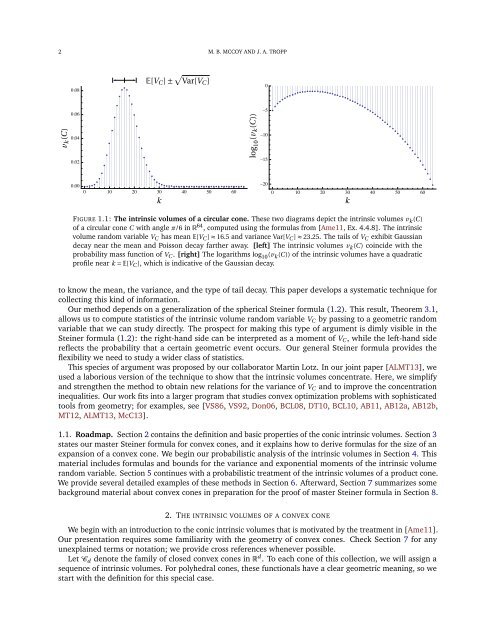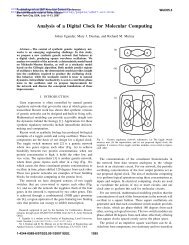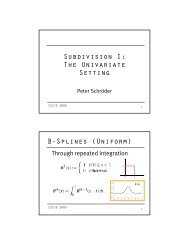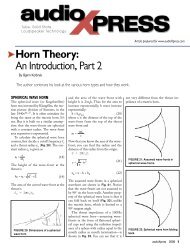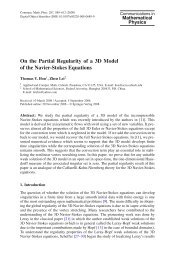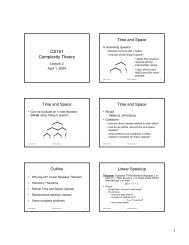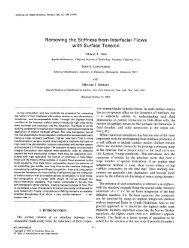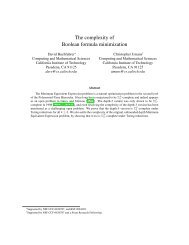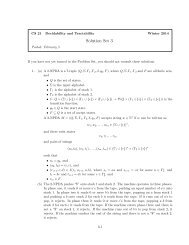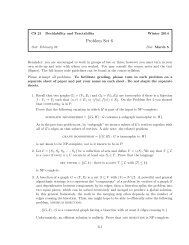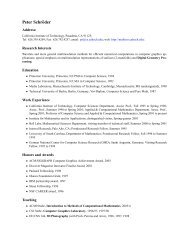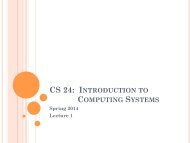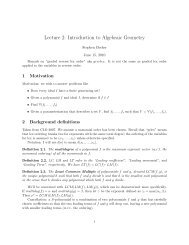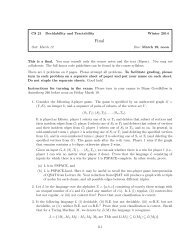From Steiner formulas for cones to concentration of intrinsic volumes
From Steiner formulas for cones to concentration of intrinsic volumes
From Steiner formulas for cones to concentration of intrinsic volumes
Create successful ePaper yourself
Turn your PDF publications into a flip-book with our unique Google optimized e-Paper software.
2 M. B. MCCOY AND J. A. TROPP0.0800.06–50.04–100.02–150.000 10 20 30 40 50 60–200 10 20 30 40 50 60FIGURE 1.1: The <strong>intrinsic</strong> <strong>volumes</strong> <strong>of</strong> a circular cone. These two diagrams depict the <strong>intrinsic</strong> <strong>volumes</strong> v k (C)<strong>of</strong> a circular cone C with angle π/6 in R 64 , computed using the <strong><strong>for</strong>mulas</strong> from [Ame11, Ex. 4.4.8]. The <strong>intrinsic</strong>volume random variable V C has mean E[V C ] ≈ 16.5 and variance Var[V C ] ≈ 23.25. The tails <strong>of</strong> V C exhibit Gaussiandecay near the mean and Poisson decay farther away. [left] The <strong>intrinsic</strong> <strong>volumes</strong> v k (C) coincide with theprobability mass function <strong>of</strong> V C . [right] The logarithms log 10 (v k (C)) <strong>of</strong> the <strong>intrinsic</strong> <strong>volumes</strong> have a quadraticpr<strong>of</strong>ile near k = E[V C ], which is indicative <strong>of</strong> the Gaussian decay.<strong>to</strong> know the mean, the variance, and the type <strong>of</strong> tail decay. This paper develops a systematic technique <strong>for</strong>collecting this kind <strong>of</strong> in<strong>for</strong>mation.Our method depends on a generalization <strong>of</strong> the spherical <strong>Steiner</strong> <strong>for</strong>mula (1.2). This result, Theorem 3.1,allows us <strong>to</strong> compute statistics <strong>of</strong> the <strong>intrinsic</strong> volume random variable V C by passing <strong>to</strong> a geometric randomvariable that we can study directly. The prospect <strong>for</strong> making this type <strong>of</strong> argument is dimly visible in the<strong>Steiner</strong> <strong>for</strong>mula (1.2): the right-hand side can be interpreted as a moment <strong>of</strong> V C , while the left-hand sidereflects the probability that a certain geometric event occurs. Our general <strong>Steiner</strong> <strong>for</strong>mula provides theflexibility we need <strong>to</strong> study a wider class <strong>of</strong> statistics.This species <strong>of</strong> argument was proposed by our collabora<strong>to</strong>r Martin Lotz. In our joint paper [ALMT13], weused a laborious version <strong>of</strong> the technique <strong>to</strong> show that the <strong>intrinsic</strong> <strong>volumes</strong> concentrate. Here, we simplifyand strengthen the method <strong>to</strong> obtain new relations <strong>for</strong> the variance <strong>of</strong> V C and <strong>to</strong> improve the <strong>concentration</strong>inequalities. Our work fits in<strong>to</strong> a larger program that studies convex optimization problems with sophisticated<strong>to</strong>ols from geometry; <strong>for</strong> examples, see [VS86, VS92, Don06, BCL08, DT10, BCL10, AB11, AB12a, AB12b,MT12, ALMT13, McC13].1.1. Roadmap. Section 2 contains the definition and basic properties <strong>of</strong> the conic <strong>intrinsic</strong> <strong>volumes</strong>. Section 3states our master <strong>Steiner</strong> <strong>for</strong>mula <strong>for</strong> convex <strong>cones</strong>, and it explains how <strong>to</strong> derive <strong><strong>for</strong>mulas</strong> <strong>for</strong> the size <strong>of</strong> anexpansion <strong>of</strong> a convex cone. We begin our probabilistic analysis <strong>of</strong> the <strong>intrinsic</strong> <strong>volumes</strong> in Section 4. Thismaterial includes <strong><strong>for</strong>mulas</strong> and bounds <strong>for</strong> the variance and exponential moments <strong>of</strong> the <strong>intrinsic</strong> volumerandom variable. Section 5 continues with a probabilistic treatment <strong>of</strong> the <strong>intrinsic</strong> <strong>volumes</strong> <strong>of</strong> a product cone.We provide several detailed examples <strong>of</strong> these methods in Section 6. Afterward, Section 7 summarizes somebackground material about convex <strong>cones</strong> in preparation <strong>for</strong> the pro<strong>of</strong> <strong>of</strong> master <strong>Steiner</strong> <strong>for</strong>mula in Section 8.2. THE INTRINSIC VOLUMES OF A CONVEX CONEWe begin with an introduction <strong>to</strong> the conic <strong>intrinsic</strong> <strong>volumes</strong> that is motivated by the treatment in [Ame11].Our presentation requires some familiarity with the geometry <strong>of</strong> convex <strong>cones</strong>. Check Section 7 <strong>for</strong> anyunexplained terms or notation; we provide cross references whenever possible.Let C d denote the family <strong>of</strong> closed convex <strong>cones</strong> in R d . To each cone <strong>of</strong> this collection, we will assign asequence <strong>of</strong> <strong>intrinsic</strong> <strong>volumes</strong>. For polyhedral <strong>cones</strong>, these functionals have a clear geometric meaning, so westart with the definition <strong>for</strong> this special case.


